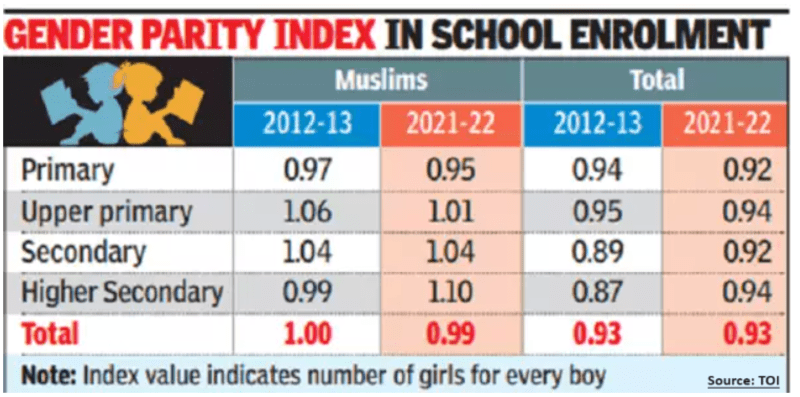News Excerpt:
A report titled "State of Muslim Education in India" based on UDISE data reveals that there is greater gender parity in the enrolment of Muslim children in schools compared to total enrolment.
Key Highlights of the report:
- There is greater gender parity in the enrolment of Muslim children in school than in total enrolment with more Muslim girls than boys being enrolled in upper primary, secondary, and higher secondary levels.

- According to data spanning from 2012–13 to 2021–22, there has been a noticeable improvement in gender parity among Muslims enrolled in primary school (class I-V), although overall Muslim enrollment skew has continued to worsen.
- The data also shows that Muslim students face challenges in transitioning to higher levels of education, with smaller shares of students progressing to the next level compared to the overall student.
- While the report does not explain why, one possible reason could be the worsening sex ratio at birth during the years preceding this period.
- India's sex ratio at birth was 905 in 2008-10, which would be reflected in the children joining primary education in 2012-13.
- This ratio kept worsening to a low of 896 in 2015-17 from where it improved to 910 in 2018-20.
- Since the children attending primary level in 2021-22 would be those born between 2011 and 2016, a period when the sex ratio at birth was steadily worsening, it is logical that there would be far fewer girls joining primary level than boys over the years.
- The improvement in the sex ratio at birth from 2016 onwards should reflect greater gender parity in primary enrolment in the coming years.
- Though Muslims have a higher sex ratio than the overall population, it has been going down among Muslims too, which could be why the gender parity index is falling for Muslim enrolment too.
Way Forward:
- Provide Financial Assistance: Offering financial support to economically disadvantaged Muslim students would help alleviate the financial burden associated with higher education.
- Scholarships, grants, and educational loans tailored to the needs of Muslim students can encourage them to pursue higher studies.
- Increase Scholarships and grants: Increasing the number of scholarships and grants explicitly targeting Muslim students would incentivize and enable them to access higher education.
- These financial aids can make a significant difference in encouraging enrolment.
- Improve Access to Quality Education: Ensuring Muslim students in rural and underserved areas have access to quality education is vital. Establishing more schools and educational facilities in these regions and improving their infrastructure and teaching standards can enhance the likelihood of students progressing to higher education.


